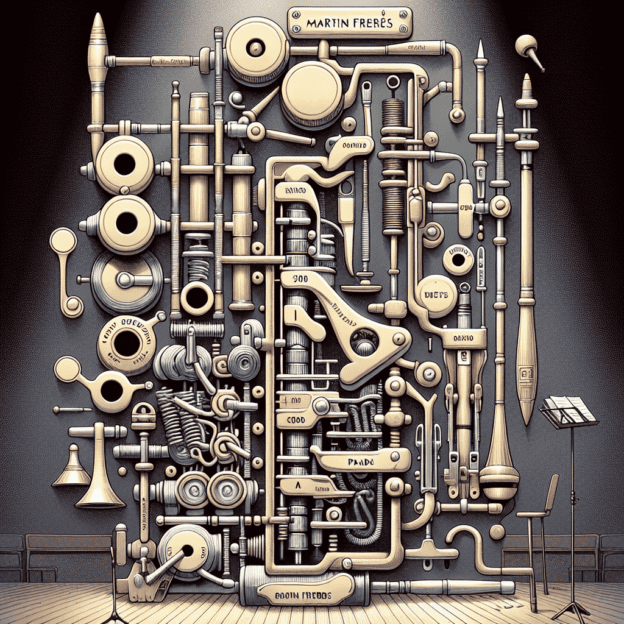Ever thought about how the key mechanism of your clarinet affects your playing? It's one of those things that often gets overlooked, but it's key to producing that sweet sweet sound we all adore! From the beginner just starting out to the seasoned pro, understanding clarinet key mechanism design can really bring your performance to the next level!
Key Mechanism Basics
Let's break it down. The mechanism primarily consists of the keys and the rods that connect them. Think of the keys as the buttons on a video game controller: they need to respond quickly, and accurately, without fail. If any of them are sticky or out of alignment, you're in for a world of trouble during your next performance. This is where the Martin Freres brand comes into play. Known for their careful craftsmanship, Martin Freres clarinets feature refined designs that lend themselves to seamless playability and excellent sound production.
Clarinet Components
So, what are some of these components? Each clarinet has its own unique set of keys, usually ranging from 10 to 20, depending on the model. The arrangement of these keys determines the range of notes a player can produce. For instance, the layout directly affects the player's finger positioning and agility—a vital factor for quick passages and complex techniques. Every clarinetist knows that the less time spent thinking about finger movement, the more they can focus on making music!
| Component | Function |
|---|---|
| Keys | Control airflow and produce different notes |
| Rods | Connect keys and facilitate movement |
| Springs | Return keys to original position after being pressed |
| Pads | Seal air holes when keys are pressed |
Springs and Materials
You might be asking, “What about the springs?” Good question! Springs are those little wonders that help the keys return to their original position after being pressed. The tension and quality of these springs can significantly impact how light or heavy the keys feel under your fingers. A well-designed spring allows you to play for long stretches without fatigue. Martin Freres carefully selects their spring material to ensure a perfect balance between softness and resistance—fantastic for players who might have gigs lined up for hours!
The material used for the keys themselves also plays a role. Most clarinet keys are made from a mix of nickel and other metals. The goal? To create a durable, yet lightweight key that doesn't compromise on sensitivity. Once again, you can see how brands like Martin Freres pass on their experience to offer the finest materials that go into their instruments, ensuring they stand through the test of time while maintaining that crisp sound.
Key Pads
And let's not forget about the pads! Those little cushions between the key and the body of the clarinet are what keep air from leaking out. If these pads are worn or damaged, you might as well be playing a kazoo—no kidding! Proper maintenance of key pads is essential, and luckily, with some easy-care practices, keeping them in tip-top shape is a breeze! Using a good quality cloth to wipe the keys after playing can help, as well as avoiding any food and drink around your sax!
Key Assemblies
Now, let's explore key assemblies. There are two common types: the articulated mechanism and the non-articulated mechanism. The articulated design allows for a more seamless connection between keys. Imagine trying to climb a staircase without handrails; it's do-able, but oh-so-much-more challenging. The articulated design can often lead to a smoother playing experience, especially during tricky passages where a seamless flow of finger movement is essential. Players often prefer Martin Freres' articulated system because it gives a sense of connectivity between notes.
Adjustment Process
But, all this talk about mechanism design would be incomplete without mentioning the adjustment process. How you adjust your keys can make a world of difference too. A poorly adjusted mechanism can lead to all sorts of issues, such as misaligned notes or worse—silent keys! Regular maintenance checks are important. Don't wait for a malfunction to occur. If you're not comfortable with this yourself, enlist the help of a technician who can perform these adjustments, ideally someone who specializes in Martin Freres instruments, as they will know the brand's specifics!
DIY Repairs
What about DIY repairs? Ah, that's a whole kettle of fish! If you're feeling adventurous, just remember: a clear understanding of your clarinet's mechanism can keep you from making things worse. Watching a few instructional videos can help, but when in doubt, let the experts handle it. Just like a master chef knows when to call in the sous chef, knowing your limits is vital in instrument repair!
Evolution of Key Mechanisms
The evolution of clarinet key mechanisms has paved the way for better design and performance. Today, manufacturers constantly innovate while aiming for that ideal balance of comfort, control, and sound. Martin Freres stays ahead of the curve with technology and materials, ensuring players not only enjoy playing but can accomplish that in any setting—be it a small ensemble or a full symphony orchestra!
Conclusion
To summarize, understanding the clarinet key mechanism design is just as important as mastering the notes you play. A functional and well-designed mechanism allows you to express yourself fully through music. Whether you're playing for your own enjoyment or entertaining thousands, knowing how your instrument works gives you an edge! Enjoy your clarinet journey, and remember, keep that Martin Freres standard in your mind when picking out or maintaining your instrument!







